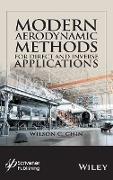- Start
- Modern Aerodynamic Methods for Direct and Inverse Applications
Modern Aerodynamic Methods for Direct and Inverse Applications
Angebote / Angebote:
A powerful new monograph from an aerodynamicist reviewing modern conventional aerodynamic approaches, this volume covers aspects of subsonic, transonic and supersonic flow, inverse problems, shear flow analysis, jet engine power addition, engine and airframe integration, and other areas, providing readers with the tools needed to evaluate their own ideas and to implement the newer methods suggested in this book. This new book, by a prolific fluid-dynamicist and mathematician who has published more than twenty research monographs, represents not just another contribution to aerodynamics, but a book that raises serious questions about traditionally accepted approaches and formulations, providing new methods that solve longstanding problems of importance to the industry. While both conventional and newer ideas are discussed, the presentations are readable and geared to advanced undergraduates with exposure to elementary differential equations and introductory aerodynamics principles. Readers are introduced to fundamental algorithms (with Fortran source code) for basic applications, such as subsonic lifting airfoils, transonic supercritical flows utilizing mixed differencing, models for inviscid shear flow aerodynamics, and so on. These are models they can extend to include newer effects developed in the second half of the book. Many of the newer methods have appeared over the years in various journals and are now presented with deeper perspective and integration. This book helps readers approach the literature more critically. Rather than simply understanding an approach, for instance, the powerful "type differencing" behind transonic analysis, or the rationale behind "conservative" formulations, or the use of Euler equation methods for shear flow analysis when they are unnecessary, the author guides and motivates the user to ask why and why not and what if. And often, more powerful methods can be developed using no more than simple mathematical manipulations. For example, Cauchy-Riemann conditions, which are powerful tools in subsonic airfoil theory, can be readily extended to handle compressible flows with shocks, rotational flows, and even three-dimensional wing flowfields, in a variety of applications, to produce powerful formulations that address very difficult problems. This breakthrough volume is certainly a "must have" on every engineer's bookshelf. This groundbreaking new volume: Is an informative critical monograph on modern aerodynamic issues drawing on rigorous mathematics and analysis Explains strengths and weaknesses of conventional methods and provides credible alternative methods Develops new approaches to aerodynamic inverse and shear flow analysis problems, written by the inventor of Boeing's supersonic drag analysis models and United Technologies' jet mixer, actuator disc, and engine and airframe integration methods Addresses important questions, such as: How do transonic oscillations affect the mean flow? How are strong shear flows modeled using simpler superpotentials without Euler's equations? Can we solve aerodynamic inverse problems in a rapid direct manner? What is the effect of engine power addition on wing aerodynamics and how are actuator disc models developed to simultaneously handle power and rotational effects? Provides commented Fortran source code for key problems, such as lifting airfoil, mixed-type transonic supercritical flow, inverse aerodynamic analysis problems, and others, with detailed explanations Presents numerous model extensions which the reader can further develop using computational methods introduced here
Folgt in ca. 15 Arbeitstagen



